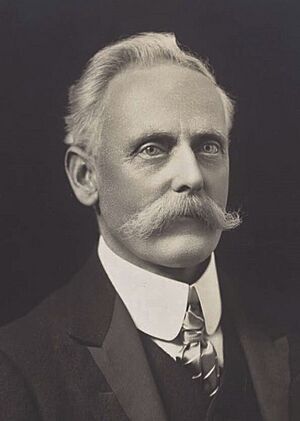National Party of Australia facts for kids
Quick facts for kids
The Nationals
National Party of Australia
|
|
|---|---|
| Abbreviation |
|
| Leader | David Littleproud |
| Deputy Leader | Kevin Hogan |
| Senate Leader | Bridget McKenzie |
| Deputy Senate Leader | Vacant |
| President | Kay Hull |
| Founder |
|
| Founded | 22 January 1920 |
| Headquarters | John McEwen House, Barton, Australian Capital Territory |
| Think tank | Page Research Centre |
| Youth wing | Young Nationals |
| Women's wing | Nationals Women |
| Membership (2021) | |
| Ideology |
|
| Political position | Right-wing |
| National affiliation | Liberal–National Coalition |
| Colours | |
| Governing body | Federal Council |
| Party branches |
|
| House of Representatives |
15 / 151
|
| Senate |
4 / 76
|
The National Party of Australia, often called the Nationals or Nats, is a political party in Australia. It is considered a right-wing party. It mainly represents farmers and people living in country areas. The party started in 1920 as the Australian Country Party.
Later, in 1975, its name changed to National Country Party. Then, in 1982, it became the National Party of Australia, which is its name today. A big goal for the Nationals is to support farmers. This can be through government help or community efforts. Sometimes, there have been questions about how these funds were given out.
The Nationals are part of a group called the Coalition at the national level. The other main party in this group is the Liberal Party, which mostly represents people in cities. When the Coalition forms the government, the leader of the National Party usually becomes the Deputy Prime Minister.
Sometimes, the Coalition has broken up after elections, but these splits have not lasted long. The way the Coalition works can be different in each state and territory. Because the two parties are so close, and because the Nationals' support has changed, people have sometimes suggested that the Liberals and Nationals should officially merge. For example, in Queensland, the Country Party (which became the National Party) merged with the Liberal Party in 2008 to form the Liberal National Party of Queensland.
The current leader of the National Party is David Littleproud. He represents an area in Queensland called Maranoa. He became leader in May 2022 after the Coalition lost the 2022 federal election. The party's deputy leader since May 2025 is Kevin Hogan. He represents the Page area in New South Wales.
Contents
History of the Nationals
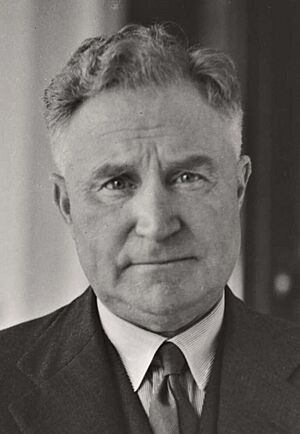
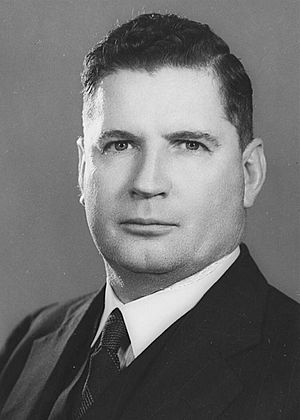
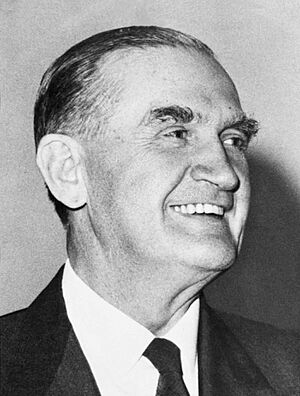
The Country Party officially started in Western Australia in 1913. It became a national party in 1920. It grew from smaller state-based groups like the Victorian Farmers' Union (VFU). The VFU won a seat in the House of Representatives in 1918.
In 1919, state Country Parties won seats in federal elections. In 1920, the Country Party became a national party. William McWilliams from Tasmania was its first leader. He said the party would work hard to help farmers. However, McWilliams was replaced by Earle Page in April 1921. McWilliams later left the party.
Historians say that large sheep farmers were often conservative. They didn't like the Labor Party, which represented workers. They worried about new laws and outside influences. Small farmers, however, were the ones who started the Country Party. They wanted the government to help with prices and marketing. Large farmers often supported the Country Party, which made the party more conservative.
The Country Party's first election as a united party was in 1922. They won enough seats to be very important. They could decide which major party would form the government. Earle Page said his party would not work with the current leader, so he had to resign. Page then worked with the new leader, Stanley Bruce, to form a government.
Page asked for five positions for his party in the government, including the important role of Treasurer. These were tough demands for a new, smaller party. But Bruce agreed, and they formed the "Bruce-Page Ministry." This started the tradition of the Country Party leader being the second most important person in the government. The party has never formed a government with the Labor Party.
Page was a strong leader until 1939. He even served as a temporary Prime Minister for a short time. The Coalition was formed again in 1940 under Archie Cameron. It continued until October 1941, even after Arthur Fadden became leader. Fadden was well-liked and a loyal deputy. When the Prime Minister had to resign, Fadden briefly became Prime Minister. However, his government soon fell, and he stepped down for Labor leader John Curtin.
The Coalition led by Fadden lost badly in the 1943 election. After that, Fadden became the deputy leader of the opposition under Robert Menzies. Menzies later formed the Liberal Party of Australia. Fadden remained a loyal partner to Menzies. He helped the Coalition win the 1949 federal election. In 1949, Fadden became Treasurer and stayed in that role until he retired in 1958. His strong partnership with Menzies helped the Coalition stay in power until 1972.
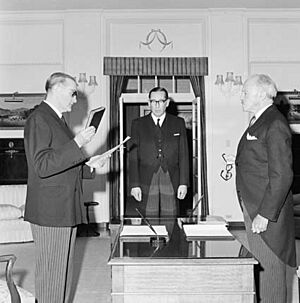
Fadden's replacement, John McEwen, chose not to be Treasurer. He wanted to make sure Australian farmers' interests were protected. McEwen helped sign important trade agreements with Japan, New Zealand, Britain, and the USSR. He also pushed for a system to protect Australian industries that added value to farm products. This was a time when the Country Party had a lot of power.
When Prime Minister Harold Holt disappeared in 1967, McEwen became interim Prime Minister. The Liberal Party's deputy leader should have taken over. However, McEwen told the Liberals that his party would not work with him. So, John Gorton became the new Liberal Prime Minister. McEwen was known for being tough in politics.
In Queensland, the Country Party, led by Frank Nicklin and Joh Bjelke-Petersen, was very strong from 1957 to 1989. For some of those years, they even governed alone. This was partly due to a system that gave rural voters more power. The party also took part in governments in New South Wales, Victoria, and Western Australia.
However, the Country Party started losing support as fewer people lived in rural areas. In 1974, the party's members in the Northern Territory joined with Liberal members to form the Country Liberal Party. This party still represents both groups in that territory.
National Country Party and National Party
From the 1970s, the National Party faced changes as more people moved to cities. Between 1971 and 1996, the population of Sydney grew a lot, but rural areas grew much less. This reduced the National Party's support base. In 1975, the Country Party changed its name to the National Country Party of Australia. This was to try and gain support in city areas. It worked a little in Queensland but not elsewhere.
The 1980s saw a disagreement between Queensland leader Bjelke-Petersen and the federal party leader Ian Sinclair. In 1987, Bjelke-Petersen tried to become Prime Minister. This plan did not work well. It helped the Labor Party win the election. Bjelke-Petersen had to retire, and his party lost badly in Queensland in 1989. The federal National Party also lost many seats in the 1990 election.
Tim Fischer became the new leader. The Coalition won a big victory in 1996, and Fischer became Deputy Prime Minister under John Howard.
In the late 1990s, the Nationals faced challenges. The Liberal Party was winning seats, and a new party, the One Nation Party, gained support from unhappy rural voters. The Labor Party also gained support in some rural areas of Queensland. In the 1998 federal election, the National Party received its lowest ever percentage of votes.
Under leaders Fischer and John Anderson, the National Party rarely disagreed with the Liberal Party in public. This made it harder for them to show they were different. In 2001 and 2004, the party continued to get fewer votes.
Experts say that two main things have caused the National Party's decline. First, the rural sector is less important to the country's economy. Second, there are growing differences in values between people in the country and in cities. This means rural voters expect more from the National Party, but its political power has decreased.
In June 2005, John Anderson resigned as leader due to health reasons. Mark Vaile took over. In the 2007 election, the Nationals' vote dropped further. Vaile resigned, and Warren Truss became the new leader.
In 2010, the party received its lowest vote percentage ever, but they gained a few more seats. In the 2013 election, their support improved slightly. In the 2016 election, under Barnaby Joyce, the party gained more seats. In 2018, there were concerns about some members' views and actions, leading to some members being removed from the party and its youth wing.
In the 2019 Australian federal election, despite challenges like drought and other issues, the National Party's vote only dropped a little. After the 2025 federal election, the Nationals decided not to sign a new agreement with the Liberals for a short time. This meant they acted separately for eight days. However, they soon reached an agreement and formed a new shadow ministry.
State and Territory Parties
The National Party has official groups in each state and territory. Here's a look at them:
| Party | Leader | Last election | Status | Federal representatives | ||||||||
|---|---|---|---|---|---|---|---|---|---|---|---|---|
| Lower House | Upper House | MPs | Senators | |||||||||
| Year | Votes (%) | Seats | votes (%) | Seats | ||||||||
| Queensland | David Crisafulli | 2024 | 41.5 |
52 / 93
|
N/A | Majority |
5 / 30
|
2 / 12
|
||||
| Northern Territory | Lia Finocchiaro | 2024 | 48.9 |
17 / 25
|
N/A | Majority |
0 / 2
|
0 / 2
|
||||
| New South Wales | Dugald Saunders | 2023 | 8.6 |
11 / 93
|
29.8 |
5 / 42
|
Liberal–National Coalition opposition |
6 / 47
|
1 / 12
|
|||
| Victoria | Danny O'Brien | 2022 | 4.7 |
9 / 88
|
29.4 |
3 / 40
|
Liberal–National Coalition opposition |
3 / 39
|
1 / 12
|
|||
| Western Australia | Shane Love | 2025 | 4.1 |
6 / 59
|
2.8 |
2 / 36
|
Liberal–National opposition alliance |
0 / 15
|
0 / 12
|
|||
| South Australia | 2022 | 0.4 |
0 / 47
|
0.7 |
0 / 22
|
Extra-parliamentary |
0 / 10
|
0 / 12
|
||||
| Tasmania | 2024 | None |
2 / 35
|
N/A |
0 / 15
|
Opposition |
0 / 5
|
0 / 12
|
||||
The Nationals' Role in Politics
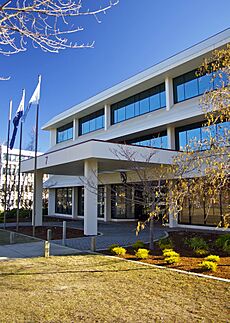
The Nationals believe their main job is to speak for Australians who live outside big cities. When the National Party and the Liberal Party form a government together, the leader of the National Party usually becomes the Deputy Prime Minister. This tradition started in 1968.
The National Party gets most of its support from farmers and people in the farming community. Historically, they have been against trade unions. The party has changed its mind over time about how much the government should help farming industries. They usually support industrial development and are often against "green politics" ideas.
The idea of "countrymindedness" was important to the Country Party for many years. This idea meant focusing on rural life and supporting farmers. It also meant asking the government for help for country areas. This idea grew because country areas were not growing as fast as cities. It became less important as more people moved to cities and as technology changed.
The Nationals' support has been decreasing. Some of their traditional supporters are now voting for independent politicians. These independents are often former members of the National Party. Since 2004, the National Party has received fewer votes than the Australian Greens.
Changes in population are also affecting the party. Fewer people live and work on farms or in small towns. Larger regional centers are growing, and some city people are moving to rural areas. The Liberal Party has also gained support because the differences between the two parties at the federal level have become less clear.
In Queensland, the Nationals leader Lawrence Springborg suggested merging the National and Liberal parties in the state. This was to create a stronger opposition to the Labor Party. This idea was first rejected but later gained support from the Liberals. However, the federal leader said the Nationals would not merge at the national level. The plan was stopped in 2006. After losing the 2006 Queensland election, Springborg was replaced by Jeff Seeney. He said he was not interested in merging unless it was a federal issue.
In September 2008, Barnaby Joyce became the leader of the Nationals in the Senate. He said his party in the Senate would not always vote with the Liberals. This gave the Labor government another way to pass laws. Joyce became the party leader in 2016. He was one of several politicians who had to leave parliament in 2017 because they held dual citizenship.
The 1987 Australian federal election was the last time the National Party received over 10% of the vote. The 2007 Australian federal election was the last time they received over 5% of the vote for the House of Representatives.
Queensland Liberal/National Merger
Plans for a merger became serious in May 2008. The Queensland state Liberal Party announced they would merge right away. The new party, called the Liberal National Party, was created in July 2008.
Election Results
House of Representatives
| Election | Leader | Votes | % | Seats | +/– | Position | Status |
|---|---|---|---|---|---|---|---|
| 1919 | None | 176,884 | 8.7 |
11 / 75
|
Crossbench | ||
| 1922 | Earle Page | 197,513 | 12.5 |
14 / 75
|
Coalition | ||
| 1925 | 313,363 | 10.7 |
13 / 75
|
Coalition | |||
| 1928 | 271,686 | 10.4 |
13 / 75
|
Coalition | |||
| 1929 | 295,640 | 10.2 |
10 / 75
|
Opposition | |||
| 1931 | 388,544 | 12.2 |
16 / 75
|
Crossbench | |||
| 1934 | 447,968 | 12.6 |
14 / 74
|
Coalition | |||
| 1937 | 560,279 | 15.5 |
16 / 74
|
Coalition | |||
| 1940 | Archie Cameron | 531,397 | 13.7 |
13 / 74
|
Coalition | ||
| 1943 | Arthur Fadden | 287,000 | 6.9 |
7 / 74
|
Opposition | ||
| 1946 | 464,737 | 10.7 |
11 / 76
|
Opposition | |||
| 1949 | 500,349 | 10.8 |
19 / 121
|
Coalition | |||
| 1951 | 443,713 | 9.7 |
17 / 121
|
Coalition | |||
| 1954 | 388,171 | 8.5 |
17 / 121
|
Coalition | |||
| 1955 | 347,445 | 7.9 |
18 / 122
|
Coalition | |||
| 1958 | John McEwen | 465,320 | 9.3 |
19 / 122
|
Coalition | ||
| 1961 | 446,475 | 8.5 |
17 / 122
|
Coalition | |||
| 1963 | 489,498 | 8.9 |
20 / 122
|
Coalition | |||
| 1966 | 561,926 | 9.8 |
21 / 124
|
Coalition | |||
| 1969 | 523,232 | 8.5 |
20 / 125
|
Coalition | |||
| 1972 | Doug Anthony | 622,826 | 9.4 |
20 / 125
|
Opposition | ||
| 1974 | 736,252 | 9.9 |
21 / 127
|
Opposition | |||
| 1975 | 869,919 | 11.2 |
23 / 127
|
Coalition | |||
| 1977 | 793,444 | 10.0 |
19 / 124
|
Coalition | |||
| 1980 | 745,037 | 8.9 |
20 / 125
|
Coalition | |||
| 1983 | 799,609 | 9.2 |
17 / 125
|
Opposition | |||
| 1984 | Ian Sinclair | 921,151 | 10.6 |
21 / 148
|
Opposition | ||
| 1987 | 1,060,976 | 11.5 |
19 / 148
|
Opposition | |||
| 1990 | Charles Blunt | 833,557 | 8.4 |
14 / 148
|
Opposition | ||
| 1993 | Tim Fischer | 758,036 | 7.1 |
16 / 147
|
Opposition | ||
| 1996 | 893,170 | 7.1 |
18 / 148
|
Coalition | |||
| 1998 | 588,088 | 5.2 |
16 / 148
|
Coalition | |||
| 2001 | John Anderson | 643,926 | 5.6 |
13 / 150
|
Coalition | ||
| 2004 | 690,275 | 5.8 |
12 / 150
|
Coalition | |||
| 2007 | Mark Vaile | 682,424 | 5.4 |
10 / 150
|
Opposition | ||
| 2010 | Warren Truss | 419,286 | 3.4 |
12 / 150
|
Opposition | ||
| 2013 | 554,268 | 4.2 |
15 / 150
|
Coalition | |||
| 2016 | Barnaby Joyce | 624,555 | 4.6 |
16 / 150
|
Coalition | ||
| 2019 | Michael McCormack | 642,233 | 4.5 |
16 / 151
|
Coalition | ||
| 2022 | Barnaby Joyce | 528,442 | 3.6 |
16 / 151
|
Opposition | ||
| 2025 | David Littleproud | 588,778 | 3.8 |
15 / 150
|
Opposition |
Leadership
List of Leaders
| # | Leader | Portrait | Electorate | Took office | Left office | Portfolio | Prime Minister (term) |
|
|---|---|---|---|---|---|---|---|---|
| 1 |  |
William McWilliams | Franklin, Tas. | 24 February 1920 | 5 April 1921 | Hughes 1917–1923 | ||
| 2 |  |
Earle Page | Cowper, NSW | 5 April 1921 | 13 September 1939 | Treasurer 1923–1929 Minister for Commerce 1934–1939 Minister for Health 1938—1939 |
Hughes 1917–1923 | |
| Bruce 1923–1929 | ||||||||
| Scullin 1929–1932 | ||||||||
| Lyons 1932–1939 | ||||||||
| Himself 1939 | ||||||||
| Menzies 1939–1941 | ||||||||
| 3 |  |
Archie Cameron | Barker, SA | 13 September 1939 | 16 October 1940 | Minister for Commerce 1940 Minister for the Navy 1940 |
Menzies 1939–1941 | |
| 4 |  |
Arthur Fadden | Darling Downs, Qld. McPherson, Qld. |
16 October 1940 acting until 12 March 1941 |
12 March 1958 | Treasurer of Australia 1940–1941, 1949–1958 |
Menzies 1939–1941 | |
| Himself 1941 | ||||||||
| Curtin 1941–1945 | ||||||||
| Forde 1945 | ||||||||
| Chifley 1941–1945 | ||||||||
| Menzies 1949–1966 | ||||||||
| 5 |  |
John McEwen | Murray, Vic. | 26 March 1958 | 1 February 1971 | Minister for Trade 1956–1963 Minister for Trade and Industry 1963–1971 |
Menzies 1949–1966 | |
| Holt 1966–1967 | ||||||||
| Himself 1968 | ||||||||
| Gorton 1968–1971 | ||||||||
| McMahon 1971–1972 | ||||||||
| 6 |  |
Doug Anthony | Richmond, NSW | 2 February 1971 | 17 January 1984 | 1972, 1974, 1975, 1977, 1980, 1983 | McMahon 1971–1972 | |
| Whitlam 1972–1975 | ||||||||
| Fraser 1975–1983 | ||||||||
| Hawke 1983–1991 | ||||||||
| 7 |  |
Ian Sinclair | Richmond, NSW | 17 January 1984 | 9 May 1989 | 1984, 1987 | Hawke 1983–1991 | |
| 8 | Charles Blunt | Richmond, NSW | 9 May 1989 | 6 April 1990 | 1990 | Hawke 1983–1991 | ||
| 9 |  |
Tim Fischer | Farrer, NSW | 19 April 1990 | 1 July 1999 | 1993, 1996, 1998 | Hawke 1983–1991 | |
| Keating 1991–1996 | ||||||||
| Howard 1996–2007 | ||||||||
| 10 |  |
John Anderson | Gwydir, NSW | 1 July 1999 | 23 June 2005 | 2001, 2005 | Howard 1996–2007 | |
| 11 |  |
Mark Vaile | Lyne, NSW | 23 June 2005 | 3 December 2007 | 2007 | Howard 1996–2007 | |
| 12 |  |
Warren Truss | Wide Bay, Qld. | 7 December 2007 | 11 February 2016 | 2010, 2013 | Rudd 2007–2010 | |
| Gillard 2010–2013 | ||||||||
| Rudd 2007–2010 | ||||||||
| Rudd 2013 | ||||||||
| Abbott 2013–2015 | ||||||||
| Turnbull 2015–2018 | ||||||||
| 13 |  |
Barnaby Joyce | New England, NSW | 11 February 2016 | 26 February 2018 | 2016 | Turnbull 2015–2018 | |
| 14 |  |
Michael McCormack | Riverina, NSW | 26 February 2018 | 21 June 2021 | 2019 | Turnbull 2015–2018 | |
| Morrison 2018–2022 | ||||||||
| (13) |  |
Barnaby Joyce | New England, NSW | 21 June 2021 | 30 May 2022 | 2022 | Morrison 2018–2022 | |
| Albanese 2022-2025 | ||||||||
| 15 |  |
David Littleproud | Maranoa, Qld. | 30 May 2022 | Incumbent | 2025 | Albanese 2025–present | |
List of Deputy Leaders
| Order | Name | State | Term start | Term end | Time in office | Leader |
|---|---|---|---|---|---|---|
| 1 | Edmund Jowett | Victoria | 24 February 1920 | 5 April 1921 | 1 year, 40 days | McWilliams |
| 2 | Henry Gregory | Western Australia | 5 April 1921 | 2 December 1921 | 241 days | Page |
| vacant | 23 February 1922 | 27 June 1922 | ||||
| 3 | William Fleming | New South Wales | 27 June 1922 | 16 January 1923 | 203 days | |
| 4 | William Gibson | Victoria | 16 January 1923 | 19 November 1929 | 6 years, 307 days | |
| 5 | Thomas Paterson | New South Wales | 19 November 1929 | 27 November 1937 | 8 years, 8 days | |
| 6 | Harold Thorby | 2 years, 262 days | ||||
| New South Wales | 27 November 1937 | 15 October 1940 | Cameron | |||
| 7 | Arthur Fadden | Queensland | 15 October 1940 | 12 March 1941 | 148 days | vacant |
| vacant | 12 March 1941 | 22 September 1943 | Fadden | |||
| 8 | John McEwen | Victoria | 22 September 1943 | 26 March 1958 | 14 years, 185 days | |
| 9 | Charles Davidson | Queensland | 26 March 1958 | 11 December 1963 | 5 years, 260 days | McEwen |
| 10 | Charles Adermann | Queensland | 11 December 1963 | 8 December 1966 | 2 years, 362 days | |
| 11 | Doug Anthony | New South Wales | 8 December 1966 | 2 February 1971 | 4 years, 56 days | |
| 12 | Ian Sinclair | New South Wales | 2 February 1971 | 17 January 1984 | 12 years, 349 days | Anthony |
| 13 | Ralph Hunt | New South Wales | 17 January 1984 | 24 July 1987 | 3 years, 188 days | Sinclair |
| 14 | Bruce Lloyd | 5 years, 242 days | ||||
| Victoria | 24 July 1987 | 23 March 1993 | Blunt | |||
| Fischer | ||||||
| 15 | John Anderson | New South Wales | 23 March 1993 | 1 July 1999 | 6 years, 100 days | |
| 16 | Mark Vaile | New South Wales | 1 July 1999 | 23 June 2005 | 5 years, 357 days | Anderson |
| 17 | Warren Truss | Queensland | 23 June 2005 | 3 December 2007 | 2 years, 163 days | Vaile |
| 18 | Nigel Scullion | Northern Territory | 3 December 2007 | 13 September 2013 | 5 years, 284 days | Truss |
| 19 | Barnaby Joyce | Queensland | 13 September 2013 | 11 February 2016 | 2 years, 151 days | |
| 20 | Fiona Nash | New South Wales | 11 February 2016 | 7 December 2017 | 1 year, 299 days | Joyce |
| 21 | Bridget McKenzie | 7 December 2017 | 2 February 2020 | |||
| Victoria | 2 years, 57 days | McCormack | ||||
| 22 | David Littleproud | 2 years, 115 days | ||||
| Queensland | 4 February 2020 | 30 May 2022 | Joyce | |||
| 23 | Perin Davey | New South Wales | 30 May 2022 | 12 May 2025 | 3 years, 207 days | Littleproud |
| 24 | Kevin Hogan | New South Wales | 12 May 2025 | Incumbent | 225 days | Littleproud |
List of Senate Leaders
The Country Party's first senators started in 1926. But the party did not have an official leader in the Senate until 1935. Before that, they had a "representative" or "liaison officer." This was so that senators could speak freely and not be told what to do by a party leader. On October 3, 1935, Charles Hardy was chosen as the first "Leader of the Country Party in the Senate." However, after Hardy's term ended in 1938, the party did not elect another Senate leader until 1949. This was likely because they had only a few senators.
The Senate leader is not always a member of the government's or opposition's main team.
| # | Name | State | Term start | Term end | Time in office | Deputy |
|---|---|---|---|---|---|---|
| 1 | Charles Hardy | New South Wales | 10 October 1935 | 30 June 1938 | 2 years, 263 days | |
| vacant | 30 June 1938 | 1949 | ||||
| 2 | Walter Cooper | Queensland | 1949 | 1960 | ||
| 3 | Harrie Wade | Victoria | 1961 | 1964 | ||
| 4 | Colin McKellar | New South Wales | 1964 | 1969 | ||
| 5 | Tom Drake-Brockman | Western Australia | 1969 | 1975 | ||
| 6 | James Webster | Victoria | 1976 | 1980 | ||
| 7 | Douglas Scott | New South Wales | February 1980 | 30 June 1985 | ||
| 8 | Stan Collard | Queensland | 1 July 1985 | 5 June 1987 | 1 year, 339 days | |
| 9 | John Stone | Queensland | 21 August 1987 | 1 March 1990 | 2 years, 192 days | |
| 10 | Ron Boswell | Queensland | 10 April 1990 | 3 December 2007 | 17 years, 237 days | Sandy Macdonald |
| 11 | Nigel Scullion | Northern Territory | 3 December 2007 | 17 September 2008 | 289 days | Ron Boswell |
| 12 | Barnaby Joyce | Queensland | 17 September 2008 | 8 August 2013 | 4 years, 325 days | Fiona Nash |
| (11) | Nigel Scullion | Northern Territory | 8 August 2013 | 28 May 2019 | 5 years, 293 days | |
| 13 | Bridget McKenzie | Victoria | 28 May 2019 | incumbent | 6 years, 209 days | Matt Canavan |
Past Government and Opposition Leaders
Federal Leaders
Queensland Leaders
Victoria Leaders
Western Australia Leaders
|
Party Donors
Political parties receive money from different sources. For the 2015–2016 financial year, some of the biggest known donors to the National Party included: Manildra Group, Ognis Pty Ltd, Trepang Services, Northwake Pty Ltd, Hancock Prospecting, Bindaree Beef, Mowburn Nominees, Retail Guild of Australia, CropLife International, and Macquarie Group.
The National Party also receives money in ways that are not always publicly known. This can happen through groups like John McEwen House, Pilliwinks, and Doogary.
See also
 In Spanish: Partido Nacional de Australia para niños
In Spanish: Partido Nacional de Australia para niños
- Young Nationals (Australia)
- Leader of the New South Wales National Party
- Katter's Australian Party
- National Party of Australia leadership spill, 2007


